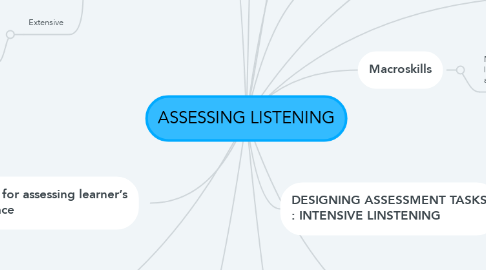
1. -Clustering -Redundancy -Reduced Forms -Performance Variables -Colloquial language -Stress, rhythm and intonation -Interaction
2. Types of listening
2.1. Intensive
2.1.1. Listening for perception of components (phonemes, intonation, discourse markers, etc)
2.2. Responsive
2.2.1. Listening for perception of components (phonemes, intonation, discourse markers, etc)
2.3. Selective
2.3.1. Processing stretches of discourse such as short monologues for several minutes in order to “scan” for certain information. Its purpose is not looking for global or general meanings, but to be able to comprehend designated information (TV or radio news items, or stories, etc)
2.4. Extensive
2.4.1. listening for the gist and main idea. (Interactive skills) “Students’ listening performance must be integrated with speaking and perhaps other skills in the authentic give-and-take of communicative interchange”.
3. Principles for assessing learner’s competence
3.1. Teachers triangulate measurements in order to make your assessment more valid and reliable.
3.2. Several tests that are combined to form an assessment.
3.3. A single test with multiple test tasks
3.4. In-class and extra-class graded work.
3.5. Alternative forms of assessment
3.6. In the case of receptive skills we can observe neither the process of performing nor the product
4. Listening process Objective Assessment
4.1. Understanding of pragmatic context. Determine meaning of auditory input. Develop comprehensive understanding.
5. What makes listening difficult?
6. DESIGNING ASSESSMENT TASKS : SELECTIVE LINSTENING
6.1. Listening Cloze
6.1.1. In a listening cloze task, test-takers see a transcript of the passage that they are listening to and fill in the blanks with the words or phrases that they hear.
6.2. Information Transfer
6.2.1. Multiple-picture-cued selection • 2. A number of people and/or actions are presented in one picture
6.3. Single-picture-cued verbal multiple- choice
6.3.1. One single photo is presented to the test- taker, who then hears four different statements and must choose one of the four to describe the photo.
6.4. Information transfer: chart-filling
6.5. Sentence repetition
6.5.1. the task of repeating a sentence/a partial sentence
7. Microskills are those that attend to the smaller bits and chunks of language (bottom-up process)
8. All assessment of receptive performance must be made by inference Language acquisition
9. Microskills
10. Macroskills
10.1. Macroskills are those that focus on the larger elements involved in a top-down approach to a listening task.
11. Performance and observations: you assess the person’s competency but you observe that person’s performance not always the performance means true competence because of external factors.
12. DESIGNING ASSESSMENT TASKS : INTENSIVE LINSTENING
12.1. Recognizing Phonological and Morphological Elements
12.1.1. Phonemic pair, consoants
12.1.2. Morphological pair, ed ending
12.1.3. Stress pattern in can't
12.1.3.1. Phonemic pair, consoants
12.1.4. One-word, stimulus
12.2. Paraphrase Recognition.
12.2.1. Sentence paraphrase
12.2.2. Dialogue paraphrase
13. DESIGNING ASSESSMENT TASKS : RESPONSIVE LINSTENING
13.1. Appropriate response to a question
13.2. Open-ended response to a question
14. DESIGNING ASSESSMENT TASKS : RESPONSIVE LINSTENING
14.1. Dictation
14.1.1. In a dictation, test-takers hear a passage, typically of 50 to 100 words, recited three times: first, at normal speed; then, with long pauses between phrases/natural word groups, and finally, at normal speed once more, during which test-takers write down what they have heard
14.2. Communicative S-R Tasks
14.2.1. • The test-taker is presented with a stimulus monologue/conversation and then is asked to respond to a set of comprehension questions. (p. 133) 1. Dialogue and multiple-choice comprehension items 2. Dialogue and authentic questions on details
14.3. Authentic Listening Tasks • .
14.3.1. 1. Note-taking: The gain of note-taking is in offering students an authentic task that mirrors what they have been focusing on in the classroom. 2. Editing: It provides both a written and a spoken stimulus, and requires the test-taker to listen for discrepancies
14.3.2. Interpretive tasks
14.3.2.1. An interpretive task extends the stimulus material to a longer stretch of discourse and forces the test- taker to infer a response
14.3.3. Retelling
14.3.3.1. In a related task, test-takers listen to a story or news event and retell it / summarize it, either orally or in writing.
14.3.4. Interactive listening
14.3.4.1. It is a two-way process of speaking and listening in face-to-face conversations.

